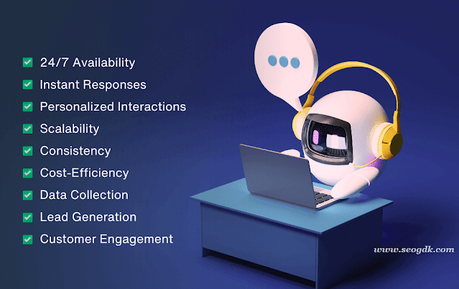

Conversion rates have become the pinnacle of success in today's fast-paced digital market, as firms compete for attention and customer engagement. The capacity to convert website visitors into loyal consumers may make or break a company's bottom line. However, the path from click to conversion is typically filled with difficulties. AI-powered chatbots, the digital realm's superheroes, are come to revolutionize website conversion rates and convert user interactions into conversions.
Conversion Rates Simplified
Conversion rates are a fundamental indicator used in digital marketing and e-commerce to assess a website's or campaign's efficiency in converting visitors into desired actions, such as making a purchase, signing up for a newsletter, or completing a form. Conversion rates, in essence, reveal how successful a website or marketing effort is at persuading people to take a specific action that matches the company's aims.
The formula for calculating the conversion rate is:
Conversion Rate = (Number of Conversions / Total Number of Visitors) × 100
Conversion rates can be calculated for a variety of actions, including:
● Sales Conversions: The percentage of visitors that purchase anything.
● Lead Conversions: The proportion of visitors who complete a form or sign up for more information.
● Conversion Rate: The proportion of users who click on a certain link or call to action.
● Download Conversions: The percentage of visitors who download a material, such as an e-book or software.
A higher conversion rate implies that a greater proportion of visitors are taking the intended action, whilst a lower percentage indicates that there is potential for improvement.
Businesses frequently test new strategies, designs, messaging, and user experiences in order to improve conversion rates. These enhancements can have a direct impact on the revenue, return on investment, and overall performance of the company. Companies may fine-tune their tactics to obtain better results and accomplish their objectives more effectively by continuously monitoring and optimizing conversion rates.
How Artificial Intelligence is Revolutionizing Chatbot Industry?
AI has sparked a revolution in the chatbot sector, providing advanced capabilities formerly reserved for human interactions. AI-powered chatbots outperform their predecessors thanks to Natural Language Processing (NLP) and machine learning. They understand human linguistic complexities and context, as opposed to rigid rule-based techniques.
This change improves user experiences. AI chatbots interact organically, comprehend query intent, and provide personalized responses. They are not static; they learn from interactions, which improves their ability to assist. This ongoing learning guarantees that they adapt to user needs, increasing happiness, conversion rates, and digital experiences.
Aspect
Normal Chatbots
AI-Powered Chatbots
Interaction Style
Rule-Based
Natural Language Processing
Responses
Limited, Predefined
More Sophisticated
Complexity Handling
Basic Queries
Complex and Nuanced Conversations
Context Understanding
Limited
Understands Context
Personalization
Limited
Offers Personalized Responses
Learning and Adaptation
Minimal
Continuous Learning and Improvement
Integration
Straightforward
Advanced Integration
User Experience
Scripted and Robotic
Natural and Engaging
AI Chatbot Integration: Boosting Website Engagement & Conversions

Here's how AI-powered chatbots can improve website conversion rates:
1. Instant Customer Engagement:
● AI chatbots respond to user inquiries immediately, minimizing wait times.
● When visitors' queries are swiftly answered, they are more likely to remain interested.
2. 24/7 Availability:
● Chatbots operate round-the-clock, providing assistance outside of regular business hours.
● This ensures that visitors always have access to support, boosting the chances of conversions.
3. Personalized Recommendations:
● AI chatbots analyze user behavior and preferences to make personalized recommendations.
● Personalization improves user experience and directs users to relevant items or services.
4. Addressing Objections and Concerns:
● Chatbots are great at managing complaints because they provide thorough information and solutions.
● Overcoming hesitations adds directly to increased conversion rates.
5. Guided Decision-Making:
● Visitors can be guided through decision-making processes by AI chatbots.
● This allows consumers to make more informed decisions, lowering abandonment rates.
6. Reduced Friction in Checkout:
● Chatbots assist users with any concerns that may arise throughout the checkout process.
● This reduces the possibility of cart abandonment due to technical difficulties.
7. Data-Driven Insights:
● Chatbots gather useful information from user interactions.
● Businesses can use this data to detect patterns, pain spots, and chances for optimization.
8. Lead Qualification and Nurturing:
● Chatbots can ask qualifying questions and segment leads based on responses.
● This allows for more targeted follow-ups and nurturing, which increases conversion potential.
9. User Engagement and Retention:
● Conversations with chatbots provide visitors with memorable experiences.
● Positive interactions lead to more visits and brand loyalty.
10. Multilingual and Multichannel Support:
● AI chatbots may converse in a variety of languages and across numerous platforms.
● This broadens the reach and accessibility of assistance, catering to a wider range of audiences.
11. Surveys and Feedback Collection:
● Chatbots can conduct surveys and collect user feedback.
● Insights from feedback lead to improvements, which improve the user experience.
12. Interactive Content Delivery:
● Content such as videos, tutorials, and guidelines can be delivered via chatbots.
● Visitors are more likely to convert when they are engaged and educated through interactive content.
13. Human-Like Conversations:
● Chatbots can engage in realistic, human-like discussions because of advanced NLP technology.
● This creates a sense of connection and trust, which is essential for conversions.
14. Cross-Selling and Upselling:
● AI chatbots can intelligently recommend complementary or enhanced products.
● Cross-selling and upselling methods can considerably boost average order value.
15. Segmented Offers and Promotions:
● Chatbots can recognize user segments and provide personalized promotions.
● Users respond better to targeted offers, resulting in increased conversion rates.
By following these tactics, AI-powered chatbots can greatly improve website conversion rates by providing a comprehensive and personalized strategy to engage with users and lead them toward desired activities.
How to integrate AI Chatbot into your website?
Step 1: Choose a Chatbot Platform
Research and select an AI-powered chatbot platform that suits your business needs. Look for features like Natural Language Processing (NLP), integration options, and scalability.
Step 2: Define Objectives
Clearly define your objectives for the chatbot. Determine if you want to improve customer support, boost sales, enhance engagement, or achieve other specific goals.
Step 3: Customize Chatbot Dialogues
Craft chatbot dialogues that reflect your brand's tone and personality. Tailor responses to align with user expectations and the objectives you've defined.
Step 4: Set Up Chatbot Logic
Configure the chatbot's logic based on user inputs. Define the scenarios in which the chatbot should offer specific responses or actions.
Step 5: Integrate Chatbot into Website
Now, let's get technical:
● Create an Account: Sign up for an account on the chosen chatbot platform and access the dashboard.
● Generate Chatbot Code: In the dashboard, find the option to generate chatbot code or script. This code is what you'll embed in your website.
● Copy the Code: Copy the generated code to your clipboard. It's typically a JavaScript code snippet.
● Access Website Code: Open your website's codebase. This might involve accessing your content management system (CMS) or editing HTML/CSS files directly.
● Embed the Code: Find the appropriate section in your website's code where you want the chatbot to appear. Paste the copied JavaScript code there.
Step 6: Test the Integration
Before going live, test the chatbot integration thoroughly. Engage in conversations, ask common questions, and ensure that the chatbot responds accurately.
Step 7: Gather Feedback and Iterate
After testing, gather feedback from users and your team. Use this feedback to make improvements, refine responses, and enhance the user experience.
Step 8: Monitor Performance
Once the chatbot is live, closely monitor its performance. Track metrics such as user engagement, response accuracy, and conversion rates to measure their effectiveness.
Step 9: Continuous Improvement
Use data and insights gathered from interactions to continuously improve the chatbot. Update responses, add new dialogues, and implement changes based on user behavior and feedback.
Step 10: Scale and Expand
As your chatbot gains traction and proves its value, consider expanding its capabilities. Explore features like integration with other systems, multilingual support, and more advanced interactions.
Step 11: Stay Updated
Keep an eye on updates and advancements in AI and chatbot technology. As the field evolves, new features and capabilities may become available that can further enhance your chatbot's performance.
Following these steps will get you well on your way to smoothly integrating an AI-powered chatbot into your website, increasing user engagement and generating conversions. Keep in mind that successful integration necessitates both technical setup and strategic alignment of the chatbot with your business objectives and user expectations.
Optimizing AI Chatbot Integration for Conversions
1. Define Clear Objectives:
Determine the primary goals you want the chatbot to achieve, whether it's improving customer support, increasing sales, or enhancing user engagement.
2. Understand User Needs:
Conduct user research to understand your audience's preferences, pain points, and communication style. Tailor the chatbot's responses accordingly.
3. Choose the Right Platform:
Select a chatbot platform that aligns with your objectives and offers features like NLP, customization options, and seamless integration.
4. Design a Conversational Flow:
Plan a conversational flow that guides users through various scenarios and user intents. Ensure smooth transitions between topics.
5. Craft User-Centric Dialogues:
Write chatbot dialogues that mirror natural human conversations. Focus on clarity, empathy, and simplicity in responses.
6. Offer Value Early On:
Provide users with valuable information or assistance right from the start of the conversation. This helps build trust and engagement.
7. Implement Context Awareness:
Equip the chatbot with the ability to understand and remember context from previous interactions. This creates a more personalized experience.
8. Optimize for Mobile:
Ensure that the chatbot is optimized for mobile devices, as a significant portion of users access websites from smartphones and tablets.
9. Consider Multilingual Support:
If your audience is global, consider offering multilingual support to cater to a diverse range of users.
10. Display Chatbot Option:
Place a visible and easily accessible chatbot icon or widget on your website. Users should know they can engage with the chatbot.
11. Allow Seamless Escalation:
Provide an option for users to seamlessly escalate to human support if the chatbot cannot adequately address their query.
12. Provide Clear Instructions:
Instruct users on how to interact with the chatbot. For example, "Type 'help' for assistance" or "Ask about our products."
13. Test Rigorously:
Thoroughly test the chatbot across various scenarios and user inputs before launching. Identify and fix any glitches or inaccuracies.
14. Monitor and Analyze:
Regularly monitor the chatbot's performance using analytics. Track metrics like engagement rates, response times, and conversion rates.
15. Gather User Feedback:
Encourage users to provide feedback on their interactions with the chatbot. Use this feedback to make improvements and refinements.
16. Iterate and Improve:
Use the data collected to refine the chatbot's responses, add new dialogues, and enhance its overall performance over time.
17. Maintain a Human Touch:
While the chatbot is automated, infuses a human touch in its responses to create a more relatable and empathetic interaction.
Keep up with advances in AI and chatbots. Update your chatbot on a regular basis to take advantage of new features and capabilities. Following these best practices will allow you to effectively incorporate an AI chatbot into your website, providing a user-friendly, engaging, and conversion-focused experience.
The Future Beckons: AI Chatbots on the Horizon
In a world that is constantly changing due to technological breakthroughs and changing user behaviors, the future of AI chatbots and website conversion rates is a bright landscape of innovation and increased user experiences.
● Hyper-Personalization: AI chatbots will offer hyper-personalized interactions based on user preferences, enhancing engagement and conversions.
● Advanced Language Understanding: Chatbots will comprehend nuances in language, sentiment, and cultural context for more relevant interactions.
● Multichannel Integration: Chatbots will seamlessly engage users across various channels, ensuring consistent assistance and higher conversions.
● Voice-Activated Chatbots: Voice interactions with chatbots will become common, providing natural and convenient engagement for mobile users.
● Predictive Recommendations: AI chatbots will proactively suggest products using machine learning, guiding users toward tailored choices.
● Emotional Intelligence: Chatbots may exhibit emotional intelligence, adapting responses based on user sentiment for stronger connections.
● Enhanced Analytics: Chatbots will offer actionable insights on user behavior, empowering businesses to refine strategies and improve conversions.
In summary, the future of AI chatbots and website conversion rates is a dynamic interplay of technology and user-centric design. Chatbots will play a critical part in generating memorable user experiences that drive conversions as they progress into intelligent, personalized, and emotionally sensitive assistants. Businesses that embrace this change will be at the vanguard of a transformative era, reaping the benefits of increased customer engagement and conversion rates.

This post was proofread by Grammarly

